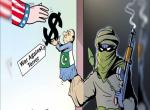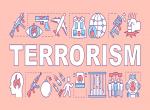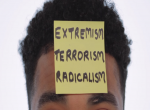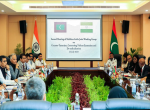It’s not just the spread of capital, goods and services which go in tandem with globalisation. The spread of terror is also a part of multifarious activities that globalisation proliferates. Information is one instrument which facilitates dissemination of the ideology and social media platform through the internet. It is the ‘New Age Media’ throwing up newer challenges almost every day to state authorities to combat fissiparous and fundamentalist ideologies. Riding on the vehicle of globalisation, the Islamic State [IS] has come a long way from being ensconced in its ‘core territory’ in Iraq and Syria to the regions of South Asia, South-East Asia, West and Central Africa.
A ‘corporate-franchisee’ relationship has developed within the overarching paradigm of terror. The 21 April 2019 Easter day suicide blasts in Sri Lanka has reaffirmed that the nascent corporate-franchisee development is being nurtured by the IS since some time now.
In the specific case of the Island nation which shares maritime border with India, Baghdadi is the self-proclaimed boss of the IS caliphate and Zaharan Hashim was the supremo of the National Thowheed Jamath (NTJ, the franchisee or local/surrogate group) based in Sri Lanka. Both individuals claim authority over fiqh or Islamic jurisprudence. The former boasts of fighting big battles against the top conventional militaries of the world, whereas the latter of late bombed his way into the media headlines. The former commanded an amalgam of jihadi forces from across the Muslim world while defending cities in Syria and Iraq, be it Raqqah, Mosul or Baghouz. The latter got indoctrinated in ultra-radical Islamic jihadi thoughts at a rather unknown Lankan town of Kathankudy in Batticaloa district.
If Baghdadi is the general in the battle of global jihad, then Hashim is the local area commander, albeit carrying the same ingredients of hate and animosity against the non-believers of Islam as Baghdadi so dearly professes. Baghdadi is the leader or Khalifa and Hashim is the follower and foot soldier, with evidently a Pir/Shagird relationship of the Sufi variety. Ironically, Hashim, like his IS boss, hated Sufism. Baghdadi shows the path and Hashim walks on it, with unflinching belief in the rationale espoused by Baghdadi and company.
Is the matter so straight and simple that Baghdadi has the remote control and Hashim is the robot in this great game of terror? Interestingly though, as fringe jihadis like Hashim get the enthusiasm of being suicide bombers from the ideological rabble-rousing by demagogues like Baghdadi et al., Abu Bakr al-Baghdadi at the other end feeds off jihadis like Hashim. If Baghdadi represents global jihad, then Hashim is the outcome of ‘glocal’ jihad.
IS-affiliates like Hashim feature a fusion of disgruntlement at the local level, duly nourished by an imported global philosophy of the IS to form a caliphate. The noteworthy aspect here is that the idea of caliphate is inherent to Islam and the caliph is the spiritual and temporal authority of all Muslims. This very idea has been dexterously exported by the IS, and Baghdadi could meticulously project himself as the ‘Caliph’ so desired (?) by all puritan Muslims. Moreover, sustained propaganda and the vitriol hurled against the non-believers could attract potential recruits not only as fighters in the main theatre of operations in Iraq and Syria, but also beyond the core area in other parts of the world – especially Africa and Asia where Muslim population is substantial.
In that regard, Hashim is not the only disciple of Baghdadi. There are several other similar ‘followers’ of Baghdadi and the concept of the caliphate – be howsoever notional and imaginary at this juncture - after the fall of Raqqa and Baghouz. It helps the IS to ‘accrete’ more followers who are ready to die for religion and the caliphate.
IS in Diverse Locales of Asia and Africa
BBC reports flaring of jihadist violence in Burkina Faso with the number of attacks in 2018 growing over 10 times since 2016. It also informed that fighters affiliated to Al-Qaeda, IS and the local Ansarul Islam have been active in the region. In a significant development, the IS has initiated efforts to attract Uighur rebels in China’s Xinjiang province. It has been reported that around 114 Uighur Muslims have joined IS between mid-2013 and mid-2014.
At the other end in Mozambique, a coastal East African country, has an Islamic insurgent group called Ansar al-Sunna. Though the group has not publicly paid allegiance to either Al-Qaeda or IS, pro-IS news wires have circulated images of Mozambican fighters, referring to them as “Soldiers of the Caliphate in Mozambique”.
In May 2019, Islamic State claimed that fighters from its affiliate West Africa Province killed 11 soldiers in an attack on a military base in the North-Eastern state of Borno in Nigeria. Interestingly, it has been reported that the leader of IS-backed faction of Boko Haram may have been supplanted as a previously unknown figure Abu Abdullah Ibn Umar Albarnawi is said to have replaced Al-Barnawi, whose father Muhammad Yusuf had founded Boko Haram in 2002. In fact, it was under Al-Barnawi that IS-affiliate West Africa Province [ISWAP] split from the faction led by Boko Haram leader Abubakar Shekau in mid-2016 in opposition to his indiscriminate targeting of civilians. Though Shekau had pledged allegiance to IS chief Al-Baghdadi in 2015 but the IS recognised only Al-Barnawi as the leader – a dynamics which clearly indicate that during 2015-16, IS had good hold over ‘decision making’ in Boko Haram, a local franchisee. However, the present replacement at the helm has not received any publicity from IS. The apparent silence of IS may suggest its lack of command and control over the ISWAP. As one report aptly put it: "IS needs ISWAP more than ISWAP needs them because of the defeat it has suffered in Syria and Iraq." Furthermore, the IS announced a ‘Central Africa Province’” and quickly claimed killing one and wounding others as the result of an assault on a Congolese army barrack.
Experts opine that IS as a group is exploiting ‘the notoriety it has banked as a global brand’. It has transformed itself to be more decentralised, turning to its affiliates/feudal groups so as to spread its philosophy and in the process enhance its lifetime. Its presence in ‘peripheral territories’, howsoever tenuous, could turn out to be highly dangerous for the internal security of the countries infested by the group. The recent May 2019 proclamations by the IS to have established ‘provinces’ in India and Pakistan indicate a grand design to extend its tentacles in South Asia. Already, its ‘Khorasan Province’ was influencing the local dynamics which has led the United Nations Security Council to place the group in the list of sanctioned terrorist organisations. Further, the terror outfit has made its presence felt in Phillipines as well as in Indonesia.
Examining the Causes
Way back in August 2016, the National Counter-Terrorism Centre in a classified document had submitted a map to the White House which showed a three-fold increase in the number of places around the globe where the ISIS was operating. In 2019, less than three years since then, the IS had grown beyond the regions shown in the ‘classified map’ by placing its feet in Bangladesh, Sri Lanka, Afghanistan, Pakistan, India, China, Indonesia and Philippines.
An expert believes that no longer are operations planned centrally by the IS. Instead, ‘it is recruiting disenchanted, disconnected younger folks, giving them the basic operational template through the dark web, and perhaps inspiring them to travel abroad to gain brief but crucial indoctrination and access to training, equipment, and explosives’. With the help of deductive logic, Richard Sindelar further opines that ‘each modern Middle East terror movement had proceeded through usually four main stages, before eventually being largely extinguished'. After the gestation period and the breakout phase, a phase of persistent violence follows which is marked by attacks over a number of years. And the final stage is the extermination of the group. According to this phenomenological model, IS presently is in the third stage after the apparent collapse of the ‘core region’ in Iraq and Syria.
But what explains this outstanding territorial reach of the IS? A fundamental cause is the skillful use of social media. A detailed research was carried out based on a dataset of 26.2 million Arabic tweets posted by pro-IS twitter handles between the 1st of July 2014 and the end of January 2015. In the past, terrorist groups generally relied on traditional mass media to spread their message. For instance, Al-Qaeda used to address the public by sending declarations recorded on video tapes to Al-Jazeera. Conversely, it has been argued that IS was the first Islamic terrorist group that made a massive usage of Internet and used social networking sites to spread its message in order to generate support.
At this stage, one basic query that emanates is what would IS gain by this territorial spread when the central caliphate is dwindling and its Caliph Al-Baghdadi is on the run. Well, the IS think-tank must have had taken a conscious decision of ‘spreading its wings’ few years ago when the ‘body’ was at its peak, so that even if the ‘core body’ gets fragmented, the ‘soul’ of the movement could ride on the wings. And violence in the most grotesque form is to be part of their agenda so that more recruits are drawn to the ultra-radical outfit in the peripheral areas and the state authorities find it all the more difficult to get hold of the group by its nose.
The IS by all means is aiming to create a network of ‘centres of violence’, similar in style with a post 9/11 Al-Qaeda wrought by American onslaught. However, the IS firmly believes in resurrecting the caliphate by utilising the terror network and especially by cultivating the psychology of terror. In fact, the group desires more violence because that would bolster their popularity and keep the hope among their followers that the caliphate has not veered away from its focus. Baghdadi and his men are emphasising on a ‘flexible caliphate’ with shifting locations of authority.
In the context of the post-Baghouz trajectory, the heads of the UN Security Council (UNSC) have warned of the dangers that foreign terrorist fighters [FTFs] pose as they spread the ideology of terrorism and violence once they return to their respective countries or scatter around instead. Council President Dian Triansyah Djani, who is also the Indonesian Permanent Representative, said that there is a possibility that FTFs who had been with IS will choose to join Al-Qaeda affiliates "in regions where they are the dominant brand". Djani’s alert indicates that there is a strong likelihood of violent Al- Qaeda-IS clashes for their hold over foreign territories.
By citing instances documented in history, J M Berger argues that the phenomenon of extremism is better understood as a product of group dynamics, that is, the ‘belief that one’s own group cannot succeed or survive unless it is constantly and unconditionally set in opposition to another group’. In this light, more gory violence is expected in the coming days as the IS clashes with Al-Qaeda and other local terrorist organisations who would not conform to the IS version of the caliphate.
How to Counter this Spread?
Tufail Ahmed wrote that counter-radicalisation strategy is to be evolved by the states at the domestic level. It should be an expected move because several domestic factors have to be taken into account since each country has different culture and reasons of the penetration of the IS radical ideology. Second, online propaganda has to be vigorously countered and censorship needs to be mulled over. Pro-IS websites, Face-Book pages/profiles and twitter handles need to be banned. Third, if the Muslims are in minority in that country, then due attention has to be given to integrate them with the mainstream so that alienation and marginalisation of the community could be avoided to the extent possible. Fourth and quite critical would be to monitor the syllabus in the Madrasas and revise it in the light of contemporary scientific developments. After the Easter bombings, the Muslim Council of Sri Lanka has issued various guidelines on the Azan, removal of Arabic sign boards, recommendations for change in behaviour and attire, reforming education sector and regulations in Madrasas. Basically, a collective identity specific to the culture of the country is to be nurtured so as to thwart incursions of radical Islamist thought by the IS.
To fit the narrative in the present context, both Baghdadi and Hashim might live and die for jihad, one might respect and worship the other, one could be the ‘elite’ jihadist and the other the ‘subaltern’, but isn’t it a little bit obvious that both are/were vying for ‘power’? In the jihadi-casino, Baghdadi remains the greater being, even though without Hashim or Al-Barnawi he is a non-entity. Baghdadi would continue to survive in this jihad and stay afloat as long as he could trick Hashims and Al-Barnawis.
(Dr. Uddipan Mukherjee, is a Joint Director in the Ordnance Factory Board, Ministry of Defence. He has published extensively on insurgency, extremism, and foreign policy. The paper is the author’s individual scholastic articulation.)
(The paper is the author’s individual scholastic articulation. The author certifies that the article/paper is original in content, unpublished and it has not been submitted for publication/web upload elsewhere, and that the facts and figures quoted are duly referenced, as needed, and are believed to be correct). (The paper does not necessarily represent the organisational stance... More >>
Image Source: https://cdn.images.express.co.uk/img/dynamic/78/590x/isis-news-1062364.jpg?r=1545747007737










Post new comment